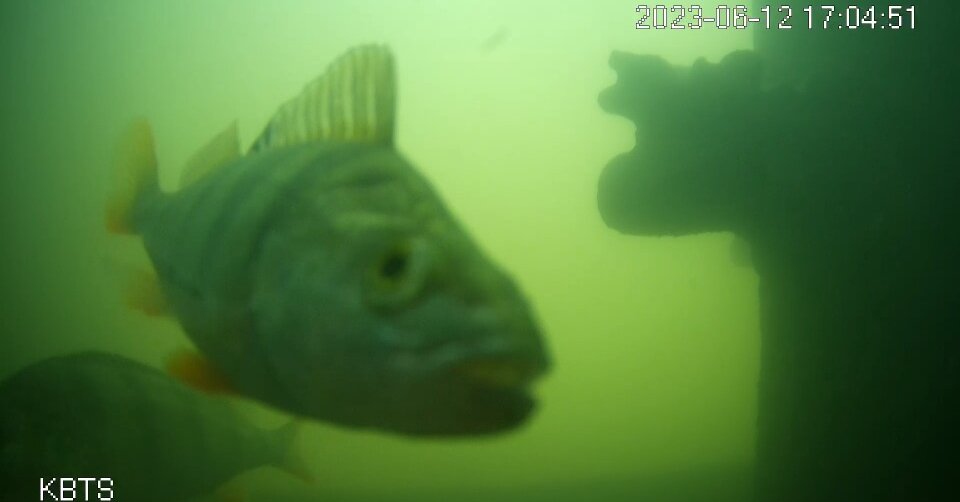When friends visit Aliza Haskal’s apartment in Syracuse, N.Y., she offers them gripping entertainment: a live feed from a camera six feet below the surface of a cloudy river in the Netherlands.
As soon as a fish glides by, Ms. Haskal hurries to press the website’s sole button. It is a doorbell — specifically, a doorbell for fish.
The button helps alert a worker in the Dutch city of Utrecht to crank open a dam, allowing the fish to wriggle toward shallower water where it can spawn.
“It’s Utrecht’s hottest sex club, accessible via fish doorbell,” said Ms. Haskal, a 24-year-old graduate student who lives more than 3,000 miles away. She thinks of herself as a kind of benevolent aquatic bouncer.
The livestream, a modest municipal project to assist fish migration, has become an unexpected hit far beyond Utrecht. In the four years since its debut, it has drawn an international audience eager to help frisky Dutch fish reach warmer waters.
The website for the fish doorbell — de visdeurbel in Dutch — has attracted more than a million users since it went live for the season on March 1. Viewers receive nothing for their participation besides the satisfaction of aiding a perch, an eel or a pike in its moment of need.
Ms. Haskal first visited the site out of curiosity about the phrase “fish doorbell,” an unexpected, irresistible pairing of words. “It is, to me, utterly hilarious that we act as a proxy to ring the doorbell because the fish have no arms,” she said.
She has stuck around for the sense of connection to people (and fish) she might never have encountered otherwise. She checks the site a few times a week, tickled whenever she can participate in “ecological teamwork,” she said.
The camera has captured pike heavy with eggs, schools of shimmery bream, a meter-long catfish and one yellow koi that was most likely released from captivity. It also caught a local university student who plunged into the river last year to wave to the camera.
Mark van Heukelum, the ecologist who created the fish doorbell, strongly discourages that approach. “I could see on his face that he didn’t expect the water to be so cold,” he said. “But he survived.”
The project began in 2020, when Mr. van Heukelum, 37, noticed during a walk around Utrecht that a group of fish had gathered outside a boat lock at the entrance to the city’s canal system. Cormorants and other predators had noticed, too, and would occasionally swoop in for an easy meal.
The boat lock, a set of dams used to maintain the canal’s water level, is closed in the spring — precisely when fish are trying to traverse the canals to spawn upstream.
With the help of Anne Nijs, an ecologist for the city, Mr. van Heukelum installed an underwater camera to keep an eye out for backups of fish. Each click of the doorbell button takes a picture that is reviewed by the ecologists. When a critical mass of fish has gathered, they alert a group of five city employees to open the lock.
At first Mr. van Heukelum had a hard time convincing other residents that the fish doorbell was not an April Fools’ prank. “The day of the opening, people were still like, ‘This has to be a joke,’” he said. (It did not help that the camera went live on March 29, 2021.)
Four years later, that skepticism has subsided. Mr. van Heukelum said he had been shocked by how many people had developed an obsession with his fish doorbell. He estimated that more than 6,300 fish passed through last year thanks to their efforts.
“Realizing that people from the U.S. or Australia or New Zealand are helping to get fish past a lock in the Netherlands, it’s such a strange idea,” he said, adding, “I am living on a cloud right now.”
Fish doorbell devotees circulate screenshots of bulging eyes peering into the camera through pickle green water. On social media, they joke about leaving their jobs behind to ring the fish doorbell full time.
Eleanor Janega, 41, a medieval historian in London, keeps the fish doorbell website pulled up on her computer next to a tab containing her preferred medieval sourcebook. She finds it both soothing and exciting — although after about 20 hours of watching, she has yet to see any fish.
“There’s this great, kind of ‘Where’s Waldo’ to it,” Dr. Janega said. When she sees a fish, she added, “It’s going to be the best moment of my life.”
Stephanie Matlock, 49, estimated that she had rung the doorbell for around 30 fish in the past two weeks from her home in Mississippi. She counsels her TikTok followers to log on around sunrise and sunset in the Netherlands, when the fish are more active.
“We’re inundated with nothing but politics, hatred, bigotry and anger for what seems like forever now,” Ms. Matlock said. With the fish doorbell, she said, “you’re helping something that you wouldn’t normally have the opportunity to help.”
The project has had some hiccups: The live feed can accommodate only about 950 viewers at a time, and the rest are redirected to a YouTube stream with no doorbell functionality.
Mr. van Heukelum is also aware that his fish doorbell is not as efficient a solution as a fish ladder, a tiered system that would allow the fish to migrate without crowdsourced help. (It is, however, significantly more charming and a lot less expensive.)
The project’s greatest success may be getting people far from the Netherlands to consider their personal involvement in helping wildlife, said Lisa Brideau, a climate policy specialist in Vancouver and the author of a climate novel.
Given that the fish doorbell appears more than adequately staffed at the moment, Ms. Brideau encouraged viewers to look for projects in their own areas to counteract human damage to natural ecosystems.
“People want that connection to nature, even if they’re living in an urban context,” she said. “The doorbell is covered: Where else can we put this energy?”
Sumber: www.nytimes.com












